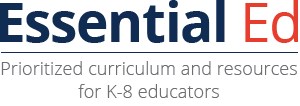Steps for personalizing unit frameworks
1. Find the right unit
Use the grade level at-a-glance document, or the unit descriptions, to find your current unit of study. Download that unit’s “Framework for Instructional Planning,” add it to your Google Drive and rename it. You may want to create a Essential Ed Curriculum folder to house all of your units.
2. Focus on knowledge and skills
First, read the essential outcomes of the unit to be sure you have a global understanding of the standards addressed and the progression of skill development.
3. Understand the unit set up
Next, review the whole unit, familiarizing yourself with the setup of the unit. Using the outline on the left side of the document can help navigate how the unit is set up. Every unit is broken into smaller groups of learning progressions centered around a specific topic or standard. Each topic has essential questions and big ideas to help narrow the instruction.
4. Review the prerequisite skills
Closely review the prerequisite skills and plan for how you will check for student readiness to learn the new concepts. Determine how you will weave in any missed foundational skills within the topic.
5. Read through unit learning progressions
Start with day one. Read the guiding questions and the student learning targets. Begin to capture resources you will use to teach each skill. Determine if any provided resources, specific to target skills, is appropriate for your needs. Insert row to include any other prioritized knowledge and skills for your class/district.
5. Plan your lessons
Determine how you will teach each lesson, what resources you will need and how you will check in on student learning. You may find that you want to add new rows for lessons that will be taught over multiple days.

